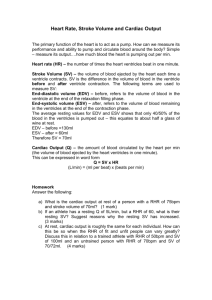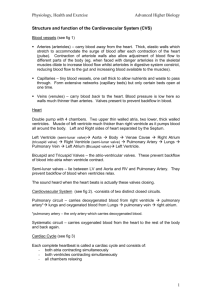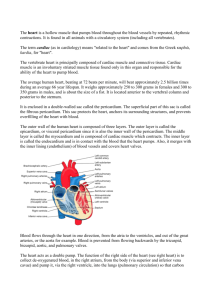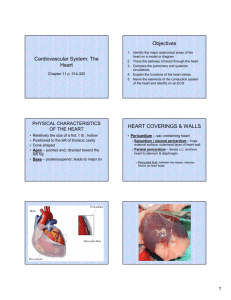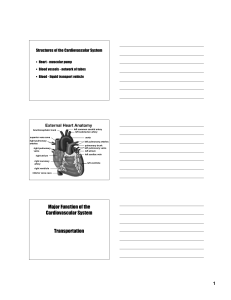Feedback_to_CV_questions
advertisement
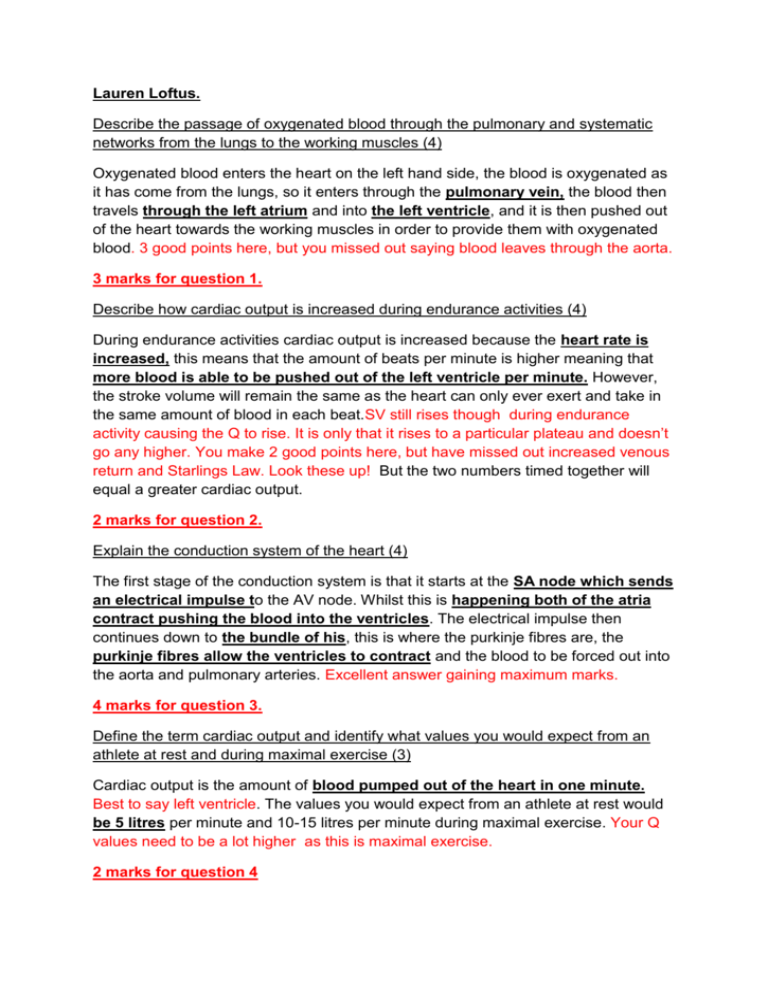
Lauren Loftus. Describe the passage of oxygenated blood through the pulmonary and systematic networks from the lungs to the working muscles (4) Oxygenated blood enters the heart on the left hand side, the blood is oxygenated as it has come from the lungs, so it enters through the pulmonary vein, the blood then travels through the left atrium and into the left ventricle, and it is then pushed out of the heart towards the working muscles in order to provide them with oxygenated blood. 3 good points here, but you missed out saying blood leaves through the aorta. 3 marks for question 1. Describe how cardiac output is increased during endurance activities (4) During endurance activities cardiac output is increased because the heart rate is increased, this means that the amount of beats per minute is higher meaning that more blood is able to be pushed out of the left ventricle per minute. However, the stroke volume will remain the same as the heart can only ever exert and take in the same amount of blood in each beat.SV still rises though during endurance activity causing the Q to rise. It is only that it rises to a particular plateau and doesn’t go any higher. You make 2 good points here, but have missed out increased venous return and Starlings Law. Look these up! But the two numbers timed together will equal a greater cardiac output. 2 marks for question 2. Explain the conduction system of the heart (4) The first stage of the conduction system is that it starts at the SA node which sends an electrical impulse to the AV node. Whilst this is happening both of the atria contract pushing the blood into the ventricles. The electrical impulse then continues down to the bundle of his, this is where the purkinje fibres are, the purkinje fibres allow the ventricles to contract and the blood to be forced out into the aorta and pulmonary arteries. Excellent answer gaining maximum marks. 4 marks for question 3. Define the term cardiac output and identify what values you would expect from an athlete at rest and during maximal exercise (3) Cardiac output is the amount of blood pumped out of the heart in one minute. Best to say left ventricle. The values you would expect from an athlete at rest would be 5 litres per minute and 10-15 litres per minute during maximal exercise. Your Q values need to be a lot higher as this is maximal exercise. 2 marks for question 4 Define stroke volume and give a resting value for the average adult. Describe the changes that take place to stroke volume from rest to maximal exercise levels (5) Stroke volume is the amount pumped out of the left ventricle in one beat of the heart. The average resting value for an adult is 60-80ml per minute for an untrained adult. There is no change placed on stroke volume between rest and maximal exercise, this is because the heart can only ever exert a set amount of blood per minute and it can also only take in a set amount of blood, this is therefore not going to increase when you are taking part in sport, the heart rate will change in order for the cardiac output to increase but the stroke volume is never going to change. You are a little confused here. There has to be a change from rest to maximal exercise. There is only no change from sub-max to max exercise. 2 marks for question 5 Total: 13 out of 20 marks. Graph question Heart rate beats per min Heart rate is the amount of times the heart beats per minute. The heart rate of a cyclist will increase before exercise due to the adrenaline building up, this is because the thought of taking part in a competition causes the cyclist to feel nervous and anticipate what is expected of them in the race which is converted into adrenaline, this is called the anticipatory rise. 60 Time Matthew Robinson 1. Oxygenated blood goes through the networks from the lungs and the heart, originally it starts with the pulmonary network and goes to left atria from the capillaries which receives the oxygenated blood, this is then linked to left ventricle where the blood is pumped to the body, the bigger the left ventricle the more blood can be pumped through the systemic network out to the arteries which take blood around the body through the blood vessels to the muscles that need it. The pulmonary circuit would start with blood entering left atrium via the pulmonary veins! Where would it go next? You make 1 point here about left atrium to left ventricle. 1 mark for question 1. 2. During endurance activities cardiac output is increased because stroke volume and heart rate increases as you exercise. Cardiac output = Heart rate x stroke volume so as you exercise your heart rate is increasing and so is your stroke volume, as you do endurance activities your left ventricle pumps out more blood so your stroke volume increases, you get to a general level called the platos when doing endurance activities so it levels out at a stage of exercising , your heart is beating faster and because of a higher heart rate and stroke volume it increases your cardiac output which is the amount of blood pumped out of the heart per minute. At rest your cardiac output is 5 litres per minute so it will increase because of heart rate and stroke volume. You have picked up 2 good points here, what about venous return though and Starlings Law? 2 marks for question 2. 3. In the conduction system at the start both atria fill with blood, pressure then forces the A.V. vales to open and the top atrium contracts, the electrical impulses go through the bundle of his and then the bundle branches to the purkinje fibres and any remaining blood then goes into the ventricles where they fill with blood. The A.V. node spread excitation and the electrical impulses through them, semi-lunar valves are then opened while A.V. valves remain closed, ventricles then contract causing increased pressure, semi-lunar valves then close to stop backflow of blood, then blood then goes to the pulmonary arteries and aorta. The aorta then sends round blood to the rest of the body. You have picked up 2 marks here underlined but you missed out how the impulse gets sent from the SA node to the AV one. 2 marks for question 3 4. Cardiac output is the amount of blood pumped out of the heart per minute and is affected by stroke volume and heart rate. At rest for both a trained and untrained athlete you would expect 5 litres of blood to be pumped out of the heart per minute. At maximal exercise your cardiac output would increase but would stay the same for both trained and untrained athletes, a trained athletes stroke volume would increase and would be more than an untrained athletes stroke volume but a trained athletes heart rate would increase but would be less than an untrained athletes heart rate as they are fitter, between them they level out so the cardiac output of both a trained and untrained athlete would be the same when doing maximal exercise. You are a little confused here. At both sub and max maximal exercise the trained athlete would have a higher Q because of his higher stroke volume than the untrained. You also have to give figures here in litres like 30-40l for the trained 2 marks for question 4. 5. Stroke volume is the amount of blood pumped out of the heart and specifically the left ventricle per beat. A resting average for an average adult would be 80ml. Stroke volume increases as you do maximal exercise because fibres can stretch more so stronger contractions therefore the left ventricle pumps more blood per beat, also there are more contractions of cardiac tissue which means the left ventricle can also pump more blood per beat. At maximal exercise the theory of Venous return is used as only so much blood can be squeezed out, this means more blood cannot be pumped round the body to the working muscles as more blood needs to be returned to the left ventricle to do this, this is so stroke volume cannot get any higher and you have to physically stop exercising. In principle you are not far off here, but you must say that SV plateaus too and that because HR is so high there is not enough time for ventricles to completely fill with blood. 3 marks for question 5. Total: 10 out of 20 marks. Adam Robinson: 1. The oxygenated blood passes through the pulmonary and systemic networks from the lungs to the muscles by firstly using the pulmonary network which is a loop through the lungs and the blood is pumped away from the heart by the pulmonary artery which travels to the lungs and then returns as oxygenated blood which then travels to the heart via the pulmonary vein. What then happens after the blood travels through the pulmonary vein? Describe the passage of blood flow through the pulmonary followed straight away by the systemic. The deoxygenated blood from the vena cava enters the right atrium of the heart and then flows through the tricuspid valve which then goes into the right ventricle; the pulmonary semi-lunar valve then pumps the blood into the pulmonary artery to the lungs. The systemic network circulates blood to all of the body except the lungs. The oxygenated blood is transported away from the heart to the rest of the body How is oxygenated blood transported away from the heart? and returns deoxygenated blood back to the heart and transports blood all over the body except the lungs. You make 1 good point here about the pulmonary vein. 1 mark for question 1 2. Cardiac output is increased during endurance activities because during exercise your heart rate becomes elevated and the body’s need for oxygen increases and the volume of blood travelling through the circulatory system increases as well. As endurance is vigorous exercise the cardiac output will increase a lot. 1 mark for mentioning heart rate, but what about increased stroke volume, venous return and Starlings Law. 1 mark for question 2. 3. The conduction system of the heart consists of cardiac muscle cells and conducting fibres that initiate impulses and coordinate the contractions of cardiac chambers. Both atria contract together and so do the ventricles but the atria contract first. The conducting system gives the heart its rhythmic beat this is so the systemic and pulmonary can operate in synchrony. This is an area you need to revisit. Here you need to say about SA to AV, impulse through bundle of his and then along purkinje fibres. 0 marks for question 3. 4.The term ‘Cardiac output’ means the volume of blood being pumped by the heart by a left or right ventricle in the period of time of one minute. For an athlete at rest I would expect them to have a low heart rate of between 50-60bpm. For an athlete participating in maximal exercise they will have a much higher cardiac output than an untrained person. You have not given me a figure for cardiac output at rest and also at max exercise. 1 marks for question 4. 5.Stroke volume is the volume of blood pumped from one ventricle of the heart with each beat. The stroke volume of an average adult is between 70-80ml. The changes that take place to stroke volume from rest to maximal exercise are that stroke volume will increase but will then stay stationary until the point of exhaustion. It is better to use the word plateaus than stationary. Also you need to explain why it plateaus and then slightly decreases at max exercise. 3 marks for question 5. Total: 6 out of 20 marks. 6.Heart rate means the number of heartbeats in a minute represented as bpm (beats per minute). The cyclist’s heart rate increases prior to exercise as the adrenaline will start to affect the cyclist before exercise and this will increase his heart rate. 7.In the sprint the cyclist’s heart rate will increase at a constant rate until the recovery stage where it will drop back to the cyclist’s resting heart rate. Harlie Browning: 1.Deoxygenated blood from the right atrium flows into the right ventricle by the tricuspid valve. This causes the ventricles contract, and then the AV valve closes off the opening between the ventricle and the atrium which then stops the blood from flowing back up into the atrium. After this the left (right) ventricle contracts, and it forces the deoxygenated blood through the semilunar valve and then flows into the pulmonary artery which then carries the deoxygenated blood to the lungs. The oxygenated blood then returns from the lung via pulmonary veins, from the pulmonary vein (what about the left atrium?) the blood then flows through and into the left ventricle then through the left bicuspid valve. The heart then contracts which forces blood in to the aorta. The arterioles meet up with capillaries, which are the blood vessels where oxygen is exchanged for carbon dioxide. You pick up 2 marks here for the underlined points. The questions is asking you to talk about pulmonary circuit first so trace the passage of blood from when it leaves the lungs! 2 marks for question 1. 2.Cardiac output means the amount of blood pumped out of the heart per minute. During endurance exercises the muscles need blood to keep contracting, so the heart needs to increase the amount of blood that is pumped that is pumped out of the heart per minute. If a person has a higher stroke volume (an athlete) they will be able to pump more blood out in one beat, so this will increase the cardiac output during exercise. Two good points here, but what about increased venous return and also Starlings Law having an impact? 2 marks for question 2. 3.The conduction system is where the heart is able to increase or decrease the cardiac output to meet the demands of oxygen needed by the working muscles. Nowhere near enough here for a 3 mark question. What about SA to AV node bundle of his etc? 0 marks for question 3. 4.Cardiac output is the amount of blood that is pumped out of the heart per minute. Cardiac output is both the heart rate and the stroke volume put together however both an athlete and a regular person will have the same cardiac output because if an athlete has a higher stroke volume they are pumping out more blood in a minute and a regular person may have more heart beats in a minute so they balance out and the cardiac output is the same. An athlete at rest would be pumping out 80-110L/min and an athlete at maximal exercise would be pumping out 160200L/min. These figures you have given are for stroke volume and not for cardiac output. What would a resting athletes Q figure be and what would it be during maximal exercise? 1 mark for question 4 5.Stroke volume is the amount of blood that is pumped out of the left ventricle per heartbeat, so if a person has a higher stroke volume this means that they will be able to pump more blood out of the left ventricle per heartbeat. The average resting value for an adult is 60-80L/min. during maximal exercise the stroke volume the heart will pump more blood out of the left ventricle per beat as it is working harder. You have failed to explain that SV would plateau during max exercise or told me why? 3 marks for question 5. Total: 8 out of 20. Bruno Horacio: 1.Deoxygenated blood from the right atrium drains into the right ventricle through the tricuspid valve. When the ventricles contract, the AV valve closes off the opening between the ventricle and the atrium so that blood does not flow back up into the atrium. When the left ventricle contracts, it forces the deoxygenated blood through the semilunar valve and into the pulmonary artery which then carries the deoxygenated blood to the lungs. The question is asking you to describe oxygenated blood flow from the lungs. This is where you must start! What happens to the blood when it leaves the lungs? All of this is not relevant to the question. The Oxygenated blood then returns from the lung via pulmonary veins, from the pulmonary vein the blood then goes in to the left ventricle (left atrium first!) through the left bicuspid valve. The heart then contracts which forces blood in to the aorta .the aorta branches into other arteries, which then branch into smaller arterioles. The arterioles meet up with capillaries, which are the blood vessels where oxygen is exchanged for carbon dioxide. 2 marks for saying that blood enters the right atrium via the pulmonary vein and leaves the left ventricle via the aorta. What have you missed out?. 2 marks for question 1. 2.Cardiac output is determined by the stroke volume. From a rest to steady exercise, cardiac output will increase rapidly and then plateau. As you train, your resting heart rate will become smaller and your stroke volume will become greater. Cardiac output will stay constant. What about increased heart rate, increased venous return and Starlings Law. 1 mark for question 2. 3.The SA node is the natural pacemaker of the heart. The SA node releases electrical stimuli at a regular rate; the rate is dictated by the needs of the body. Each stimulus passes through the myocardial cells of the atria creating a wave of contraction which spreads rapidly through both atria. The electrical stimulus from the SA node eventually reaches the AV node and is delayed briefly so that the contracting atria have enough time to pump all the blood into the ventricles. Once the atria are empty of blood the valves between the atria and ventricles close. At this point the atria begin to refill and the electrical stimulus passes through the AV node and Bundle of His into the Bundle branches and Purkinje fibres. As the ventricles contract, the right ventricle pumps blood to the lungs where carbon dioxide is released and oxygen is absorbed, whilst the left ventricle pumps blood into the aorta from where it passes into the coronary and arterial circulation. At this point the ventricles are empty, the atria are full and the valves between them are closed. The SA node is about to release another electrical stimulus and the process is about to repeat itself. Excellent answer. This is the standard I expect. 4 marks for question 3. 4.Cardiac output is the amount of blood pumped out of the heart every minute. You need to say that it is out of the left ventricle too. An athlete should pump out 30/40L of blood every minute at maximal exercise. At rest an athlete should pump out 5/7L of blood every minute. You have identified the correct Q figures here. Well done! 3 marks for question 4. 5.Stroke volume is amount of blood pumped by the left ventricle of the heart in one contraction. For an athlete the stroke volume and maximal exercise should be 100/120ml The stroke volume for an average person at rest should be 70/80ml when a person is at rest the stroke volume is 70/80ml and when they are doing exercise it doesn’t change this is because you heart can’t change the amount of blood it suddenly pumps out but what it can do is change the speed in which this process happens. It is not correct to say that SV does not change during exercise. It has to change because more blood is needed to be pumped out. It does though reach a plateau when during sub max exercise and drops slightly at max exercise. Do you know why? 2 marks for question 5. Total: 12 out of 20 marks. James Lofthouse: 1. Heart rate is the number of complete cardiac cycles, therefore the number of times the left ventricle ejects blood in to the aorta per minute. With submaximal exercise when exercise starts there is a rapid increase in heart rate, until it eventually plateaus at the maximal level (steady state), then when recovering there is a rapid decrease in heart rate. Whereas with maximal exercise it begins with a rapid increase when exercise starts and then goes into a slow increase until it reaches the maximal level at a peak, during recovery there is a rapid decrease and then a slower decrease until resting heart rate is reached. (both start with an anticipatory rise). 2. Deoxygenated blood is sent to the right hand side of the heart through the pulmonary artery where it is pumped out of the heart through the aorta to the lungs to get oxygenated this is called pulmonary circulation. It returns in the left hand side of the heart through the pulmonary vein and the oxygenated blood is then circulated around all the working muscles going out of the heart through the vena cava this is called systemic circulation. What happens to the blood once it leaves the lungs? It travels along pulmonary vein, but how does it enter and then leave the heart? 1 mark for question 1. 3. During endurance activities cardiac output is increased as Q=HR x SV, as heart rate and stroke volume are both increased. Cardiac output on a graph increases linearly until the maximum capacity is reached and it plateaus as it cannot go any higher. Cardiac output represents the ability of the heart to circulate blood around the body, delivering the oxygen to working muscles. During the maximum exercise, it may reach values 5 times your resting value, thus is a major factor for determining your endurance capacity. Two good points but you have missed out venous return and Starlings Law. 2 marks for question 2 4. The electrical impulse starts at the SA node which is in the right atrial wall. The rate at which it releases the electrical impulse determines the heart rate. It emits an impulse which goes through fibres of the atrium and spread rapidly. It eventually gets to the AV node which acts as a distributor and passes the impulse on to the bundle of his. These together with Purkinje fibres spread the excitation through the ventricles. 3 good points but what about the atria contracting? 3 marks for question 3 5. Cardiac output is the amount of blood ejected from the heart per beat. You have failed to say that it is over a minute. An athlete at sub-maximal exercise should be around 15-20 litres per min, at maximal 30-40 litres per min. The question asks for figures at rest not at sub max exercise. Your max answer is correct. 1 mark for question 4. 6. Stroke volume is the volume of blood ejected from the heart per beat. Say out of left ventricle not just heart. The resting value for an adult is around 60ml. With exercise stroke volume increases and more blood is pumped out per beat, then it plateaus at the maximal level. After this it decreases at high levels of intensity. It decreases as the heart rate is too high thus the ventricles do not have required time to fill up and pump more blood out. Excellent answer identifying the reasons behind the plateau and slight decrease at max exercise. 5 marks for question 5. Total: 12 out of 20 marks. Jack Carse: 1)The rate at which the heart beats; usually measured to obtain a quick evaluation of a person's health. The cyclist may have anticipation for the event he will be taking place in, this could lead to release a hormone in his body called adrenaline, this increase the heart rate. He also may feel nervous for his event; this also increases the heart rate. 3)Blood starts off by traveling through the pulmonary vein, then enters the left atrium, passes through the bicuspid valves and AV valves, then the left ventricle and through the semi lunar, penultimate it pumped through the aorta and finally it travels via the arteries, arterioles and capillaries in order to reach the muscles. This is an excellent answer covering all the major points. 4 marks for question 1. 4)Exercise greatly increases blood flow to active muscles and tissues. The level and intensity of exercise determines the level of cardiac output. Low impact exercise such as stretching or walking will slightly increase cardiac output. During intense exercise, such as interval training, weight training or running, tissues require many times over the normal amount of oxygen transported via blood. Cardiac output is increased significantly. You have missed the main part of the question here. You need to talk about increases in HR, SV, VR and also Starlings Law. 0 marks for question 2. 5)The heart conduction system includes four parts, these are: - SA Sinoatrial Node - AV Atrioventricular node - Bundle Branches Left/Right - Purkinjie Fibres The SA Node is the natural Pacemaker in the heart. The Heart Beat starts from the SA node and travels down to the AV node and into the Left and Right Branches which then travels down to the Purkinjie Fibres This is when the Ventricles Contract. 1 mark here as you have failed to draw the link between the impulses emitted and both atrial and ventricular contraction. Also you have missed describing the role of the bundle of his. 1 mark for question 3. 6)Cardiac output is the amount of blood pumped out by the ventricles in a given period of time. You must say it is over a minute and you have failed to give a resting value for Q. An athlete’s cardiac output during maximal exercise would be 30-40L. Correct figure for Q during max exercise. 1 mark for question 4. 7)In cardiovascular physiology, stroke volume (SV) is the volume of blood pumped from one ventricle of the heart with each beat. The average stroke volume for a non-trained male adult is 70ml per beat. The stroke volume increase majorly when participating in exercise. More so if its maximal then sub-maximal. This is because the blood needs to be pumped round the body as quick as possible to suffice the muscles needs. You have not said why Sv would plateau or drop slightly during max exercise. 3 marks for question 5. Total: 9 out of 20 marks Lorna Simpson: 1.The systemic circulation conducts oxygenated blood from the left ventricle to all the major muscles and organs of the body (excluding the lungs) and returns it to the left atrium via the vena cava. Therefore when the oxygenated blood leaves the pulmonary artery, it travels to the muscles that require oxygen. The oxygen is passed through the blood to the muscles. When it leaves the lungs this is when it travels to the muscles. The pulmonary system conducts blood between the heart and the lungs. You seem a little confused here. You are right in saying that the pulmonary circuit involves blood flow between the lungs and the heart, but describe the passage this blood takes. 0 marks for question 1. 2.The faster the heart beats, the more blood is pumped around the body, therefore the more oxygen in going to the muscles that require it. This will increase with endurance activities because more blood is needed for the working muscles. With the increase in blood required, this will make the heart beat faster to get more oxygen around the body. Only 1 point made here. What about increased SV and VR? Also you have failed to mention Starlings Law. 1 mark for question 2. 3.The heart produces impulses that spread and innervate specialised muscle fibres. Unlike the skeletal muscles, the heart produces its own impulses. It is the conduction system of the heart that spreads the impulses throughout the heart and enables the heart to contract. You need to describe the actual conduction system here. What about SA node to AV and atrial contraction to start? What follows? 0 marks for question 3 4.Cardiac output is the volume of blood that is pumped out of the heart, from one ventricle, per minute. For an athlete at rest, the values should be 60-80 beats per minute. You have given the HR figures and not the ones for Q at rest. This is because they have bradycardia, this is having a low resting heart rate as a result of continued aerobic exercise. During sub maximal exercise, these values will increase to approximately 200 beats per minute. 1 mark for question 4. 5.Stoke volume is the volume of blood pumped out of the heart per beat. It usually refers to the blood that is ejected from the left ventricle and is usually measure in ml (miliitres) or cm3. For an average adult, the stroke volume is about 75ml, this can increase significantly in a trained athlete. The changes that take place from rest to maximal exercise levels is that the amount of blood pumped out of the heart increases. This is because the muscles that are being worked require more oxygen, therefore more blood is needed to be pumped around the body. What about SV plateau and dropping slightly during max exercise. Why does this happen? 3 marks for question 5. Total:5 out of 20 marks. Liam Daly: 1)Deoxygenated blood from the right atrium flows into the right ventricle through the tricuspid valve. When the ventricles contract, the AV valve closes off the passage between the ventricle and the atrium, so that a back flow of blood is prevented. When the right ventricle contracts, it forces the deoxygenated blood through the semilunar valve and into the pulmonary artery which then carries the deoxygenated blood to the lungs. The oxygenated blood then returns from the lung via pulmonary veins, from the pulmonary vein the blood then goes in to the left atrium through the bicuspid valve. The heart then contracts which forces blood in to the aorta. The aorta then takes the blood to all the other parts of the body. 3 good points here, but you missed out the left ventricle. Also the first part of your answer is a waste because the question talks about passage of oxygenated blood 3 marks for question 1. 2)Cardiac output is determined by the stroke volume. From a rest to steady exercise, cardiac output will increase rapidly and then plateau. As you train, your resting heart rate will become smaller and your stroke volume will become greater. Cardiac output will stay constant. You have only mentioned 1 point here that of stroke volume. What about venous return and Starlings Law? 1 mark for question 2. 3)The SA node releases electrical stimuli at a regular rate; the rate is dictated by the needs of the body. Each stimulus passes through the nerve cells of the atria creating a wave of contraction which spreads rapidly through both atria. The electrical stimulus from the SA node eventually reaches the AV node and is delayed briefly so that the contracting atria have enough time to pump all the blood into the ventricles. Once the atria are empty of blood the valves between the atria and ventricles close. At this point the atria begin to refill and the electrical stimulus passes through the AV node and Bundle of His into the Purkinje fibres. As the ventricles contract, the right ventricle pumps blood to the lungs where oxygen is absorbed, whilst the left ventricle pumps blood into the aorta from where it passes into the coronary and arterial circulation. At this point the ventricles are empty, the atria are full and the valves between them are closed. The SA node is about to release another electrical stimulus and the process is about to repeat itself. Good answer on the whole, but you failed to draw the link between the Purkinje Fibres and the ventricles contracting. 4 marks for question 3. 4)Cardiac output is the amount of blood pumped out of the heart every minute. Add on here that it is out of the left ventricle. An athlete should pump out 30/40L of blood every minute at maximal exercise. At rest an athlete should pump out 5/7L of blood every minute. Correct figures for Q at rest and during max exercise for an athlete. 3 marks for question 4. 5)Stroke volume is amount of blood pumped by the left ventricle of the heart in one contraction. The stroke volume for an average person at rest should be 70/80ml when a person is at rest the stroke volume is 70/80ml and when they are doing exercise it doesn’t change this is because you heart can’t change the amount of blood it suddenly pumps out but what it can do is change the speed in which this process happens. Your stroke volume must change once you start exercising as more blood is pumped out of the heart. Why would it plateau though at a particular point? 2 marks for question 5. Total: 13 out of 20 marks. Kim Hutchinson: 1. from the lungs, the oxygenated blood goes back to the heart via the pulmonary artery, it then goes into the right atrium. There the tricuspid valve opens to let the blood go in to the ventricle, a short pause to let the rest of the blood into the right ventricle. Then, the purkinje fibres cause the ventricle to contract and the blood is pumped around the body to the working muscles where oxygen is used so the muscles can respire to make glucose for their energy. You are confused here. You need to start with the passage of oxygenated blood from the lungs back to the heart. How does it travel there? Then what route does it take before it leaves? 0 marks for question 1. You have missed out Describe how cardiac output is increased during endurance activities (4) 2. the conduction system starts at the SA node in the right atrium, sends an electrical impulse to the AV node causing the atria to contract. The valves open letting the blood go into the right ventricle, a short pause which allows the rest of the blood to enter the ventricle before the electrical pulse goes to the bundle of his. Once it’s reached the bundle of his, the purkinje fibres cause the ventricle to contract and the blood is pumped around the body. Good answer, but you could have said that the impulse travels along bundle of his along pukinje fibres which then cause the ventricles to contract. 3 marks for question 3. 3. Cardiac output is the amount of blood pumped out of the left ventricle in one minute. The values you would expect from an athlete at rest is HR= 50bpm, SV= 105ml, Q= 5L per minute. During maximal exercise: SV= 160/200ml per minute, Q= 30/40L per minute. Excellent answer with the correct figures. 4. Stroke Volume is the amount of blood pumped out of the left ventricle in 1 beat. Values for an average adult is HR= 70bpm, SV= 75ml, Q= 5L per minute. At rest the SV of an average adult is 75ml but during maximal training the SV goes up to 100/120ml per beat. As they work harder using maximal training, the amount of blood pumped out of the heart increase because their heart muscles are getting stronger so therefore will be able to pump out more blood. What about the SV plateau and slight decrease during max exercise? Can you give reasons why here? 4 marks for question 5. Total: 7 out of 20 marks

